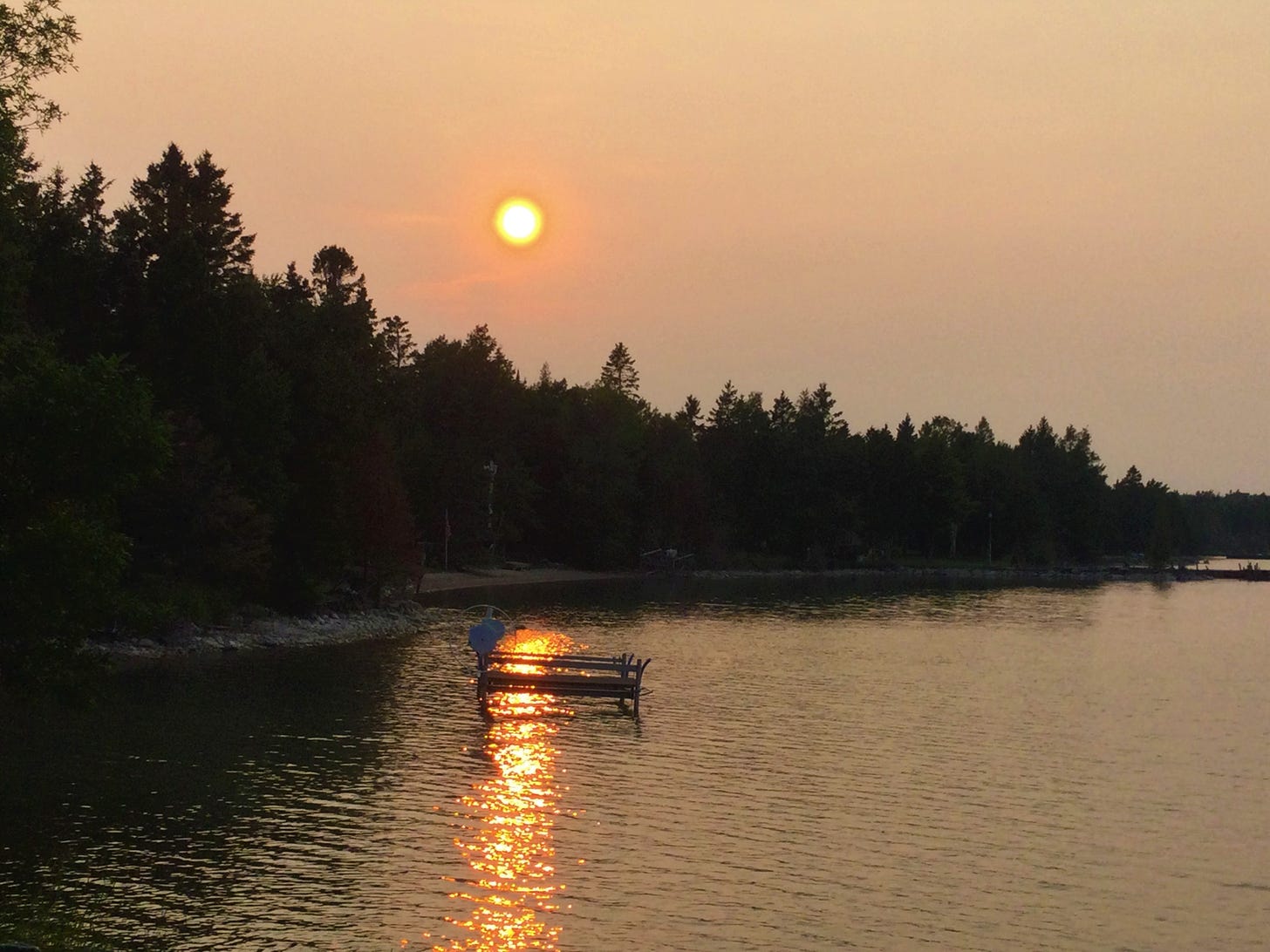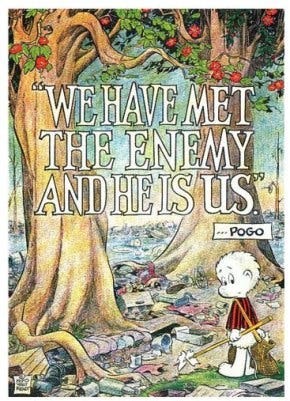Celebrating Earth Day While the Patient is Dying
On the 53rd anniversary, an homage and a warning.
Sorry for the interruption, friends. I don’t usually send out posts two days in a row, but I just realized today is Earth Day in America and I’ve made it a habit to post a revision of this early piece every year on this anniversary.
So here it is:
The first Earth Day, 53 years ago, was a big deal. It was 1970. We were still in the mood to celebrate the earth and to warn against the destruction of our natural places. Now we’re watching again as our supposed caretakers are licking their lips at the thought of all that land open to rape-for-profit.
I’m tired of having to remind those who live on this planet that the earth is our only home. We owe it to her–and to ourselves–to keep her healthy. At some point we have to heed the warnings.
We’re at the stage now where the earth would be better off without us.
Gaylord Nelson, Democratic senator from Wisconsin, founded Earth Day as both a celebration and a warning. He wrote:
On April 22, 1970, 20 million people, 2,000 colleges and universities, 10,000 grammar and high schools and 1,000 communities mobilized for the first nationwide demonstrations on environmental problems. Congress adjourned for the day so members could attend Earth Day events in their districts. The response was nothing short of remarkable, and the modern American environmental movement took off.
My major objective in planning Earth Day 1970 was to organize a nationwide public demonstration so large it would, finally, get the attention of the politicians and force the environmental issue into the political dialogue of the nation. It worked. By the sheer force of its collective action on that one day, the American public forever changed the political landscape respecting environmental issues.
I remember that first Earth Day, April 22, 1970. The scope of it was astonishing and really surprising. It was a grassroots movement in the best sense of the phrase, and we all felt good about it. (Most of us, that is. The day after, The Daughters of the American Revolution branded the Earth Day commemoration “distorted” and “subversive”. It didn’t help that the first Earth Day happened to fall on the 100th anniversary of Vladimir Lenin’s birth.)
What Gaylord Nelson originally proposed was a nationwide teach-in on school campuses. He chose April 22 because it would fall after Easter break but before final exams. It was spring. The earth was renewing itself. Environmentalism was gearing up and in motion, and it was a fine time to give the earth a day.
Richard Nixon was president and, while he didn’t participate in any of the day’s events (maybe because a damned Democrat came up with the idea), he was actively talking about attacks on the environment and the steps the government would need to combat them. Pollution was a big issue already, and steps had been taken to de-smog the cities. It was working. (Nelson had actually talked to JFK in the early 60s about the need to draw attention to the environment, and a day to commemorate had been thrown out there then. Nothing happened.)
Industry was king, and the environmentalists, alarmed at water, ground and air pollution levels, were talking to brick walls (when they weren’t batting their heads against them). In 1962, the year Rachel Carson published “Silent Spring”, 750 people died in London’s smog. In 1965, four days of inversion held down a cloud of filthy air that killed 80 people in New York City. In 1969, Cleveland’s Cuyahoga River caught fire. Earlier that year, an oil platform six miles out from Santa Barbara, California, blew out, spilling 200,000 gallons of oil, creating an 800 square mile oil slick that settled on 35 miles of California shoreline. Almost 4,000 birds were killed, along with fish, seals and dolphin.
Enough had finally become enough, and under Lyndon Johnson and a congress that could see clearly now (even though the rest of us were still lost in a choking, eye-watering, salmon-colored, man-made smog), we saw a Clean Air Act, a Clean Water act, a National Wilderness Preservation System, a Wild and Scenic Rivers Act, a National Trails System Act, and, for what it was worth, a National Environmental Policy.
That all changed, of course, when Ronald “A tree is just a tree” Reagan became president. For the Department of Interior, he chose James Watt, a notorious anti-environmentalist, to head it. He chose Ann Gorsuch, another determined anti-earthling, to head the Environmental Protection Agency. What a laugh that was–or might have been, if it weren’t so serious. They were chosen for the same cynical reasons George W. Bush chose his department heads—so that regulatory agencies could, from the inside, be forced to stop regulating.
Gale Norton, GWB’s choice for Secretary of Interior was called “even worse” than James Watt, by the Defenders of Wildlife. I shuddered over that one. I remembered James Watt and I thought nobody could cause as much havoc on our little section of the earth as that little man did.
I thought we had learned something along the way. I thought all those Arbor Days and Earth Days and global warming warnings had taught us all something. Some of us obviously weren’t listening.
Earth Day is getting almost no play in the news and on the internet, which may be why it almost got past me this year. That’s sad. Wouldn’t it be great to see crowds out there giving it their all — marching and chanting in solidarity over saving Earth’s last breath?
What I wouldn’t give for a sea of tie-dyes and peace signs and flower garlands…
The aroma of Pachouli…
All those things I thought were pretty silly back then are looking pretty good to me as I take note of the day we promised to give Earth a chance.
“Sometimes I wonder if Lewis and Clark shouldn’t have been made to file an environmental impact study before they started west, and Columbus before he ever sailed. They might never have got their permits. But then we wouldn’t have been here to learn from our mistakes, either. I really only want to say that we may love a place and still be dangerous to it. We ought to file that environmental impact study before we undertake anything that exploits or alters or endangers the splendid, spacious, varied, magnificent and terribly fragile earth that supports us. If we can’t find an appropriate government agency with which to file it, we can file it where an Indian would have filed it–with our environmental conscience, our slowly maturing sense that the earth is indeed our mother, worthy of our love and deserving of our care.”
Wallace Stegner, Where the Bluebird Sings to the Lemonade Springs
For more reading on this day you can’t beat Rachel Carson:






It's almost too sad to even talk about. Here in the Poconos, where I've lived for 50 years now, a dear friend and one of the finest pianists I've ever known just spent a part of several days filling trash bags with items thrown out by passing cars. Yes, people love to come here and dispose of their trash wherever they feel like it. There are cans everywhere, but why stop to dispose of a few items when it's so easy to toss them out of a car window? So my friend gives up hours of practice and wades through poison ivy and deals with tics and other noxious insects because he wants to do his part for this little corner of the world he loves. And he's not alone, many join him, and if I could get my back to cooperate I would as well. I know that seems a small thing .. but is it, really? Isn't it a symptom of how carelessly we view the earth we live on? George Carlin was right, though, I think. The earth will be here long after humanity has managed to destroy itself.
Thanks Ramona - so timely AND so important! Decided to "share" this to my FB Feed. One very small attempt to raise more awareness :-)